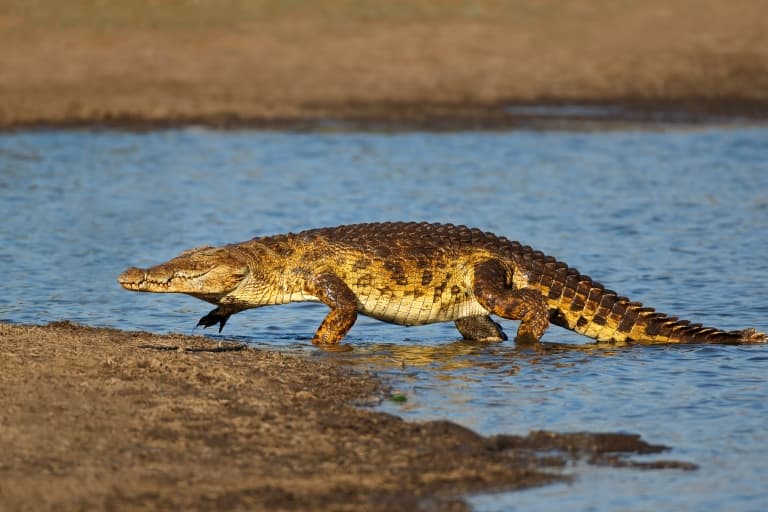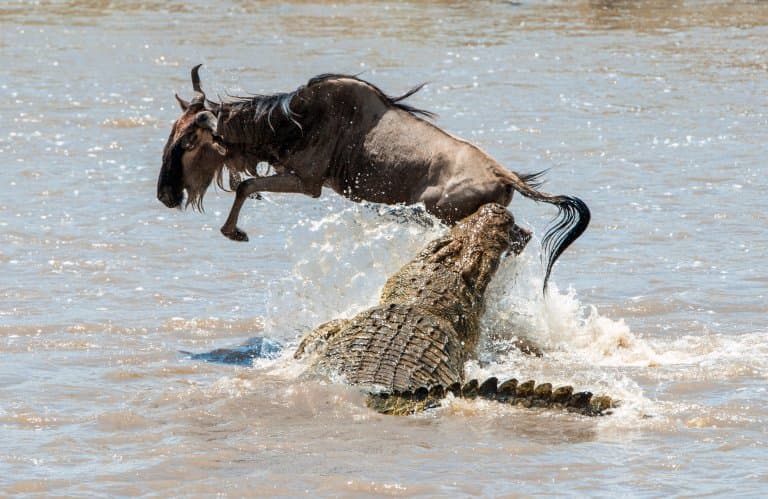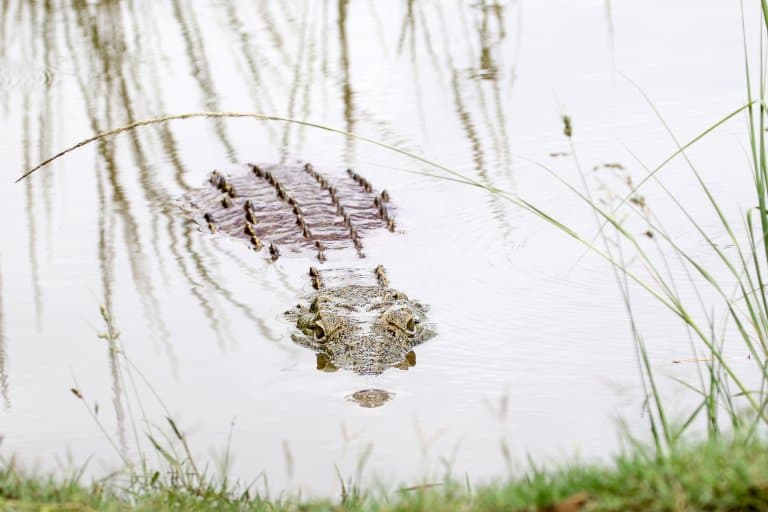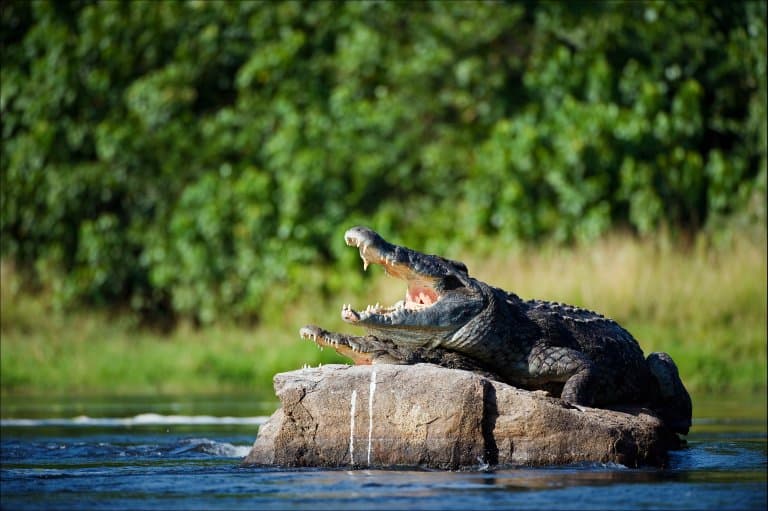Nile Crocodile Profile
Contemporary philosopher Sterling Archer had this to say about his most primal fear:
“Maybe deep down I’m afraid of any apex predator that lived through the K-T extinction. Physically unchanged for a hundred million years, because it’s the perfect killing machine. A half ton of cold-blooded fury, the bite force of 20,000 Newtons, and stomach acid so strong it can dissolve bones and hoofs”.
While this insightful diatribe overstates the American crocodile that inspired it, there is an older African relative that exceeds this description on most counts: the Nile crocodile.
The Nile crocodile is a large, aggressive crocodilian species that lives in freshwaster lakes, rivers, swamps and marshlands across 26 countries in Africa. Their scientific name ‘niloticus’ means “from the Nile River”, in reference to their historical range which extended as far as Egypt.

Nile Crocodile Facts Overview
| Habitat: | Rivers and lakes |
| Location: | Africa |
| Lifespan: | 60 years |
| Size: | Up to 5 meters long |
| Weight: | Can exceed 1,000kg |
| Colour: | Brown/Yellow, sometimes green |
| Diet: | Mostly large mammals, some fish, reptiles, birds |
| Predators: | None/sometimes humans |
| Top Speed: | 4 km/h (8.7 mph) |
| No. of Species: | 1 |
| Conservation Status: | Least Concern (IUCN) |
Nile crocodiles are one of the oldest of the extant crocodilians, thought to stem from the ancestor of American crocodiles, and have survived significant shifts in environmental conditions and human development.
These are remnants of a prehistoric past, but with certain more recent attributes that have made them resilient to extinction events that took out many other animals of their size.
Their strength comes from their exceptionally low-maintenance lifestyle and precision instrumentation, giving them a low metabolic requirement and a highly specialised hunting capability.
Interesting Nile Crocodile Facts
1. They can grow to more than a ton
One of the first things that’s notable about the Nile crocodile is its mass. This is a huge reptile; one of the largest on earth. While not quite as massive as the infamous salty from Australia and Asia, Nile crocs are the largest species of crocodile in Africa.
Males are typically 30% larger than females and they can grow to over 5m (16ft 5) long and, if left to their own devices, can exceed a ton in weight. And they accomplish this feat with a surprisingly slim diet.
However, these sizes are increasingly uncommon, as large individuals are often killed by humans whose environment overlaps.

2. Their stomach is impressive
You’d think an animal that eats large mammals and goes weeks between meals would have a huge stomach, but most nile crocs can’t store more than about 35cm3 or roughly the volume of a basketball.
Inside this stomach is one of the most hostile environments of any gastric system, in which stomach acid and specially-acidified blood is pumped at ten times the effectiveness of mammalian systems.
The stomach breaks down bone, horn, shell and hoof, extracting all the valuable nutrients and further allowing it to outlast its prey for the next meal. 1
3. They probably have the strongest bite of any animal
When it comes to catching animals, Nile crocs have the most powerful weapon. A bite force of 22,000 Newtons has been recorded, higher than that of any other animal.
For some perspective, a human bite will commonly max out at around 150 Newtons.
This force is generated using a special ratchet system in the jaw and a modified mandible joint, which both work to store huge amounts of energy while the mouth is open and expend it in a hurry when the bite is triggered.
The snout of a crocodile is a sensory array, extremely fine-tined to pressure and movement. By some metrics, they’re more sensitive than human fingers, and this precision combines with the immense bite force to help bring down large prey quickly.
They also have have 64-68 sharp cone-shaped teeth that can be replaced when broken. 2
4. They’re an apex predator
There’s nothing bigger or meaner than a Nile crocodile in their range. These are specialised ambush hunters that have honed their craft well, and while their stamina isn’t great for any kind of long-distance chase, they have exceptional speed and power to lunge when the opportunity arises.
This strategy confines them predominantly to the water for hunting, but in their habitat, the lack of water makes their environment a priority gathering point for their favourite prey.
Once fed, they can go for very long periods without needing to hunt again.
5. Nile crocodiles are ambush predators
This means they will wait for hours, days or even weeks without moving much for the right moment to attack and ambush their prey.
Their dark bronze color and green eyes help them blend into the background.
They will often lay submerged and concealed in the water and wait for an animal to come to the waterway to take a drink, before suddenly lunging forward and grasping prey with their jaws.
Larger animals will be dragged underwater and drowned, before being ripped apart and eaten.
It’s not just in water they can attack though, nile crocodiles can lay near forest trails at night up to 50m from the waters edge, ready to ambush.
They will hunt and eat a variety of mammals, fish, reptiles and birds.

6. They survived the extinction that killed the dinosaurs
This low-maintenance lifestyle is likely what allowed crocs to survive the extinction of the dinosaurs. Most animals their size were wiped out around 66 million years ago during the K-T Extinction.
Being able to stay put for weeks until a morsel of food finally wanders into your mouth can be a huge advantage when times are hard. We know that freshwater ecosystems were more resilient to extinction than marine habitats, so it may also be that Nile crocodiles were in the right place at the right time to help them succeed where others didn’t.
7. They have changed
Crocodilians are indeed an ancient lineage. They’re Archesaurs, like birds and other ancient reptiles, including dinosaurs.
Archosaurs first show up in the fossil record around 250 million years ago, but crocodilians don’t appear for much longer. While their lineage diverged from birds very early on, animals we’d recognise as modern crocodiles don’t show up until around 95 million years ago.
Consequently, despite superficially resembling lizards, crocodiles are far more closely related to birds than other reptiles like snakes and lizards, by around 100 million years.
During that time, they have changed a lot. But identifiable features of modern crocodiles would have been present in ancient ancestors as far back as the Jurassic period, around 150 million years ago, meaning that these animals found an evolutionary strategy that worked for them and stuck with it longer than most.
One ancient adaptation might hold clues to this strategy and is still puzzling researchers today. 3
8. They breathe like birds
One lesser-known quirk of bird physiology is their uni-directional airflow system. While we as humans have to tidally expel used air from our lungs before we can fill them with a fresh load, birds use a system of sacs that allows for a continuous passage of oxygenated air across their lung surface.
While the advantage of this to high altitude exertion of flying animals is obvious, this adaptation is curiously present in crocodiles too and predates known flight in vertebrates by a wide margin.
The reason for this is not yet understood, and even animals long familiar to science are still surprising scientists with their respiratory systems.
It might be that the very same efficiencies that allow birds to breathe while conserving energy also aid in crocodilian physiology when it comes to sitting submerged in water for prolonged periods.
It’s well known that Nile crocodiles have good hearing and a wide vocal repertoire, especially in juveniles, but also between adults.
One purely speculative but highly exciting hypothesis would be that ancient archosaurs developed these incredibly complex respiratory systems in response to an increasingly complex vocal language, much in the way the size and dexterity of the human tongue reflect the evolution of our own speech.
While our own system has had between 50,000 and 3 million years to develop, archosaurs have had hundred of millions of years of evolution inside which to evolve more complexity. 4
9. They don’t sweat
To keep cool, they open their mouths which is known as “mouth gaping,” very similar to panting.
They are not displaying aggression when you see them with their mouths wide open! They often sleep with their mouths wide open to release heat.

10. Nile crocodiles are relatively social
These large crocs are mostly solitary, but will share basking spots and even share large prey, such as mammals or schools of fish. They have also been observed working together for food, by blocking migrating fish by forming a semicircle across the river.
A group of crocodiles is referred to as a float, a bask, a nest or a congregation!
In these groups, they will use each other for leverage to perform infamous ‘death rolls’, where they twist their body to tear off large pieces of meat to eat.
Their social hierachy is largely determined by size, larger and older males are dominant. When respect is infringed, there are often violent and aggressive results that can be fatal.
Mothers will also work together to look after their offspring, forming a creche.
11. Only 1% of hatchlings will survive
During the mating season, males will try and attract females by bellowing, and slapping their snouts against the water.
When a female shows interest, they mate with the male aggressively pinning the female underwater.
Two months after mating, females will lay between 25 – 80 eggs by digging a hole a few metres from the bank of the water, laying the eggs, then covering them with sand or soil to incubate.
The female will then guard the eggs for 3 months, until they hatch. Hatchlings are around 10-12 inches in size and weigh only 70 grams at this stage.
It’s estimated that only 10% of eggs survive to hatch, and then only 1% of hatchings actually make it to adulthood due to predatation, and natural causes.

12. They are responsible for hundreds of human deaths each year
Nile crocodiles are aggressive when they are encroached upon and have the strongest tendencies to treat humans as prey.
They are estimated to kill hundreds of humans each year, which is more than any other crocodile species including the larger saltwater crocodile. This is because they live in such close proximity to human populations through most of its range.
A 2008 study claimed that there are between 275 – 745 attacks on humans each year, of which 63% are fatal. In comparison to just 30 attacks by the larger saltwater crocodile, which 50% are fatal. 5
Nile Crocodile Fact-File Summary
Scientific Classification
| Kingdom: | Animalia |
| Phylum: | Chordata |
| Class: | Reptilia |
| Order: | Crocodilia |
| Family: | Crocodylidae |
| Genus: | Crocodylus |
| Species: | Crocodylus Niloticus |
Fact Sources & References
- “Crikey! How crocs digest animals whole”, NBC News.
- RACHEL BAXTER (2016), “THE SECRET OF THE CROCODILE BITE”, Biosphere Online.
- Richard E Green (2014), “Three crocodilian genomes reveal ancestral patterns of evolution among archosaurs”, NIH.
- C. G. Farmer (2015), “Similarity of Crocodilian and Avian Lungs Indicates Unidirectional Flow Is Ancestral for Archosaurs”, Oxford Academic.
- Dr. Richard Fergusson (2008), “Crocodilian Attacks”, Crocodile Specialist Group.
